65+ identity theft statistics to know going into 2025
Identity theft has been the most frequently reported type of cybercrime for the past five consecutive years.
As many as 24 million Americans may be falling victim every year, resulting in economic losses exceeding $16 billion.
There are some positive developments, however: 42% of businesses plan to increase their investment in cybersecurity.
Curious to learn more?
Here’s an overview of identity theft statistics, facts, and trends for 2024.
Updated on: January 21, 2025
Table of Contents
10 key identity theft statistics
Here are our top picks of identity theft stats from recently published reports:
- Experts estimate that identity theft happens every 22 seconds.
- Identity theft was the most common form of fraud in 2023 (accounting for 19% of all frauds reported to the FTC).
- Identity theft cases made up 26% of cybercrimes in 2023.
- The largest share (34%) of identity theft cases involved online methods like phishing, unauthorized transactions, and remote access.
- Approximately 24 million Americans reportedly had their identity stolen over a twelve-month period, according to a report from the Bureau of Justice Statistics.
- Millennials (37%) and Gen X (29%) made up the majority of identity theft victims in 2023.
- Sources say that 20% to 34% of Americans have experienced identity theft in their lifetime.
- 55% of US businesses reported identity theft attempts involving fake physical documents in 2023.
- Credit card fraud cost Americans $246M in 2023, averaging $2.2K per victim.
- From 2018 to 2024, the estimated number of identity theft victims had risen by 1,400%.
Before we begin
Identity theft does not have a standardized, nationwide definition.
Some sources differentiate identity theft from identity fraud, treating them as two distinct types of incidents.
However, throughout this article, we’ll use the terms “identity theft” and “identity fraud” interchangeably, following the definition provided by the Bureau of Justice Statistics.
That is—
“Identity theft is a fraud, committed or attempted, using a person’s identifying information without authority.”
Having that squared away, let’s get going!
General overview of identity theft in the US
Some of the statistics below are from 2021.
That’s not because the information is outdated.
The Bureau of Justice Statistics—the authority that offers the most comprehensive analysis of identity theft—releases these reports every couple of years.
The stats here are drawn from the latest one, published at the end of 2023.
Here are some general statistics about identity theft:
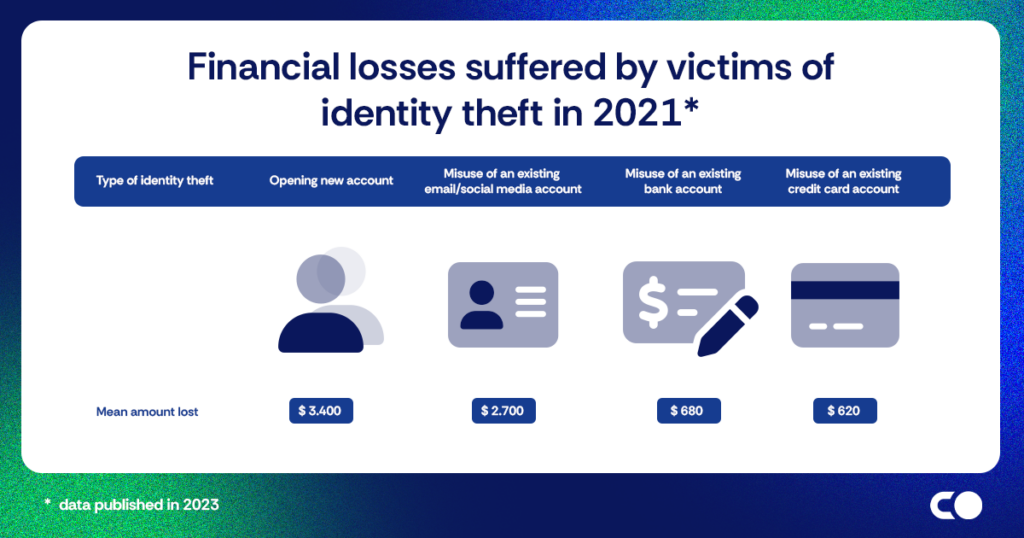
- The FTC received 5.7 million reports of fraud, with 1.4 million of these being identity theft cases.
- About 10% of Americans had their identities stolen in 2021.
- Nearly 60% of people who had their identities stolen in 2021 lost money.
- In 2021, on average, each victim lost $1,160, with the median value at $200.
- Only 21% of identity theft victims in 2021 knew how it happened.
- In 2021, 37% of identity thefts were done online.
- In 2023, 47% of document frauds targeted national ID cards, 24% targeted passports, and 18% targeted driving licenses.
- The FTC received 5.4 million fraud reports in 2023, with over 1 million pertaining to identity theft.
- In 2023, the most common identity theft involved credit card use, making up 31% of reports.
Related: Can someone steal your identity with your ID (or license)?
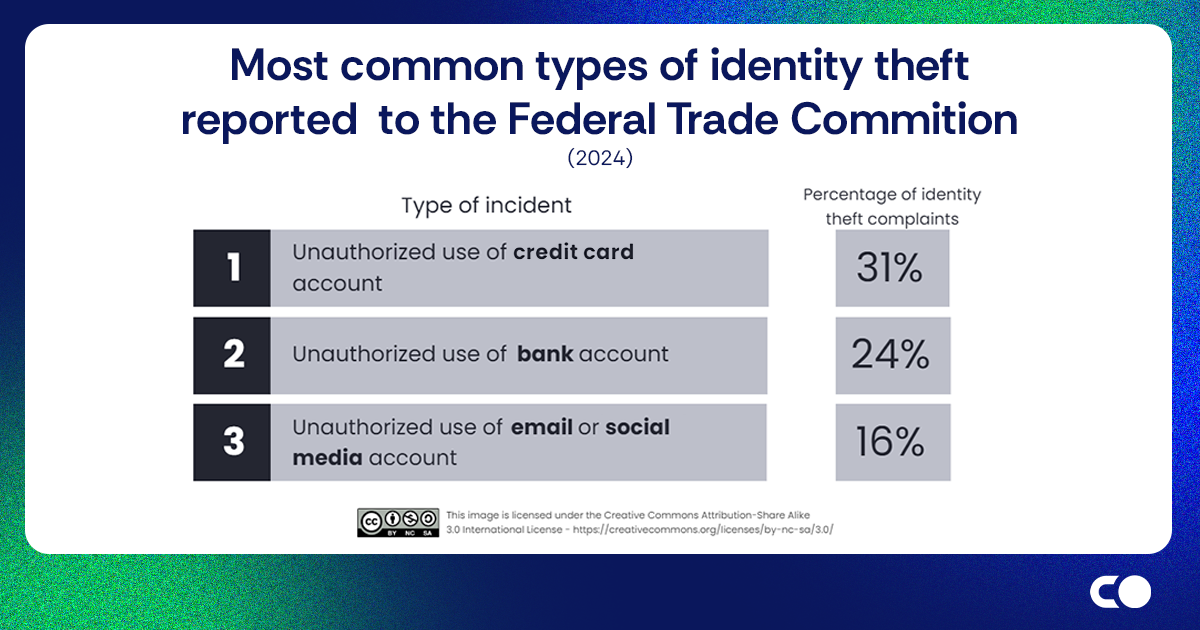
Source: Federal Trade Commission, Consumer Sentinel Network Data Book 2023
In-depth look at identity theft
But let’s take a closer look at the types of identity theft cases.
Estimates vary on how rapidly this dangerous trend is growing:
- TransUnion’s report shows that identity theft frauds more than doubled, increasing by 113% from 2019 to 2023.
- The FTC says identity theft complaints went up by 54% from 2019 to 2023.
- In 2020 and 2021, the FTC received a record 1.4 million identity theft complaints each year, which is a 115% rise from 2019.
Here’s a detailed overview of the FTC’s stats on identity theft from 2019 to 2023:

Source: Federal Trade Commission Consumer Sentinel Network Data Book 2023
- In 2021, 76% of identity crimes involved using the victim’s existing accounts.
- In 2021, opening new accounts caused the most financial losses to victims, with an average loss of $3,400.
- Victims of credit card fraud in 2021 lost an average of $620.
- In 2021, 25% of identity theft victims found out through their bank, 19% noticed suspicious activity, and only 9% realized it by losing money.
- More than half of the victims (56%) resolved their identity theft issues in one day or less.
- About 30% of victims have faced multiple types of identity theft in their lifetime.
- In 2023, people aged 30 – 39 were the most common victims, making up 30% of cases.
- Americans under 19 mostly faced employment or tax-related identity theft in 2023, accounting for 62% of cases.
- Identity thefts were the most reported type of fraud in 2023, making up 94% of all reports, followed by phishing (at 88%) and online dating scams (at 82%).
Related: How to check if someone is using your identity?
The typical identity theft victim
In this section, we’ll delve into the profiles of identity theft victims.
That means examining their ages, methods of fraud discovery, subsequent interactions, and more.
- Millennials (37%) and Gen X (29%) made up the majority of identity theft victims in 2023.
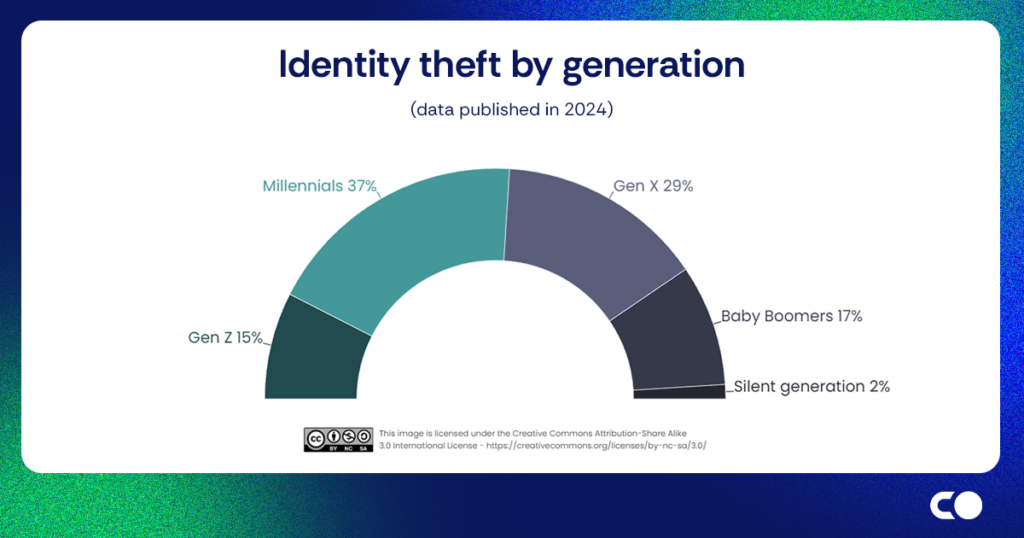
Source: The Annual Cybersecurity Attitudes and Behaviors Report 2023
- More women (54%) than men (46%) experience identity theft.
- Most identity theft victims are White (70%), followed by Hispanic (12%) and Black (11%) individuals.
- In 2021, the largest group of victims were people earning between $50,000 and $100,000 a year, making up 32% of all cases.
- People earning over $200,000 a year were the smallest group of victims, at 11%.
- Most victims (86%) were able to fix their financial or credit problems after identity theft.
- After falling victim to identity theft, 71% of people changed their passwords on financial accounts, compared to 48% of those who weren’t affected.
- Many Americans (43%) don’t know what to do if they get hacked online.
- Only 39% of victims knew who to contact and how to report identity theft.
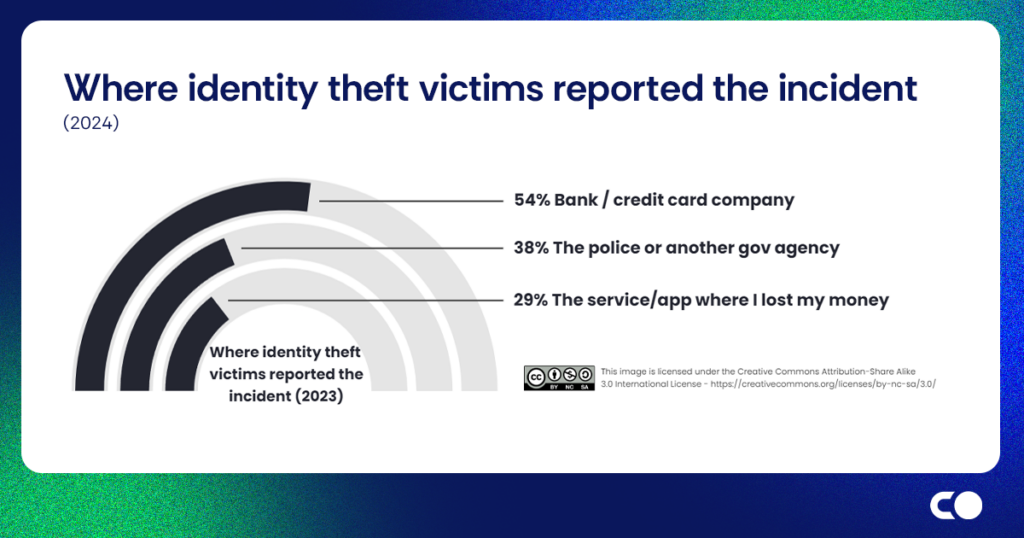
Source: The Annual Cybersecurity Attitudes and Behaviors Report 2023
- Interestingly, 13% of identity theft victims reported the incident to their family for them to take care of it.
- 10% of identity theft victims were severely distressed by it.
Why identity theft will likely rise in 2025
Identity theft is on the rise.
Why is that?
The accessibility of generative AI, growing numbers of data breaches, and the emergence of fraud-as-a-service could be some pieces of the puzzle.
While we can’t provide a definitive answer, these statistics might offer some insight:
- National Public Data suffered a massive data breach of over 2.9 billion records in 2024, likely affecting every American citizen.
- Phishing attacks increased by 1,265%, driven by the growing popularity of Gen AI.
- Deepfake attempts increased by a factor of 31 in 2023 compared to the previous year.
- Cyberattacks were the leading cause of personal data theft, responsible for 74% of breaches in 2023.
- Between 2022 and 2023, 30% of businesses saw an increase in data and security breaches.
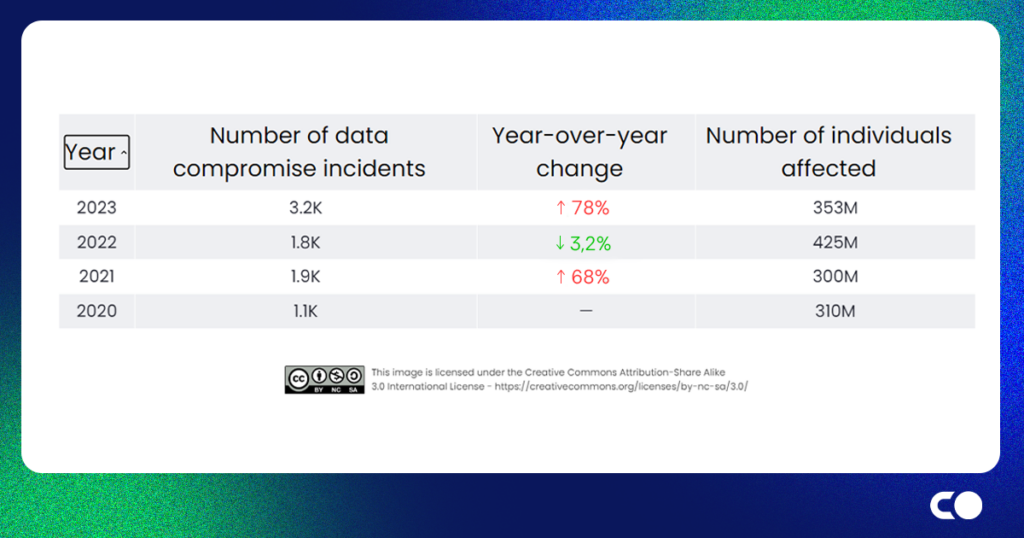
Source: Identity Theft Resource Center, “Annual Data Breach Report”, 2024
There’s a new player joining the game: Synthetic Identity Theft.
It’s a blend of real personal information with fabricated details, such as data created by AI.
- Synthetic Identity Theft makes up 85% of all identity fraud cases found by Authentic.
- In 2024, 49% of companies worldwide reported fraud incidents involving deepfakes.
- In 2023, 47% of businesses reported increases in the numbers of cases of Synthetic Identity Theft.
- In 2024, digital document forgeries went up by 244% compared to the previous year.
But that’s not all.
You see, some aspects—like the statistics mentioned—are beyond our control.
However, there are others that are a direct result of our own actions.
Like how we approach online privacy.
Here’s how Americans manage their personal data on the web:
- 29% of Americans don’t consider privacy a big deal.
- 21% of US adults trust their data handlers will “act responsibly,” 38% fear identity theft or misuse.
- 16% of US smartphone users don’t use security features to lock their phones.
- 46% of Americans prefer passwords that are easier to remember, even at the cost of security.
- 63% of Americans aged 65+ write down their passwords.
- 38% of Americans use personal information in their passwords.
- 40% use simple dictionary words with character substitutions (e.g., p@ssw0rd).
But it’s not all doom and gloom—
There’s some gold in them hills:
- 42% of businesses plan to boost tech investment to fight fraud in 2024.
- Some machine learning tools detect document fraud with 99%+ accuracy.
- 56% of consumers prioritize personal data security when choosing a bank.
- 68% consider identity fraud risks in their financial activities and purchases.
- 76% of social media users aged under 50 updated their privacy settings at least once.
- 42% of US internet users aged under 50 use encrypted messaging apps.
- 90% of those aged 16+ have taken at least one action to prevent identity theft.
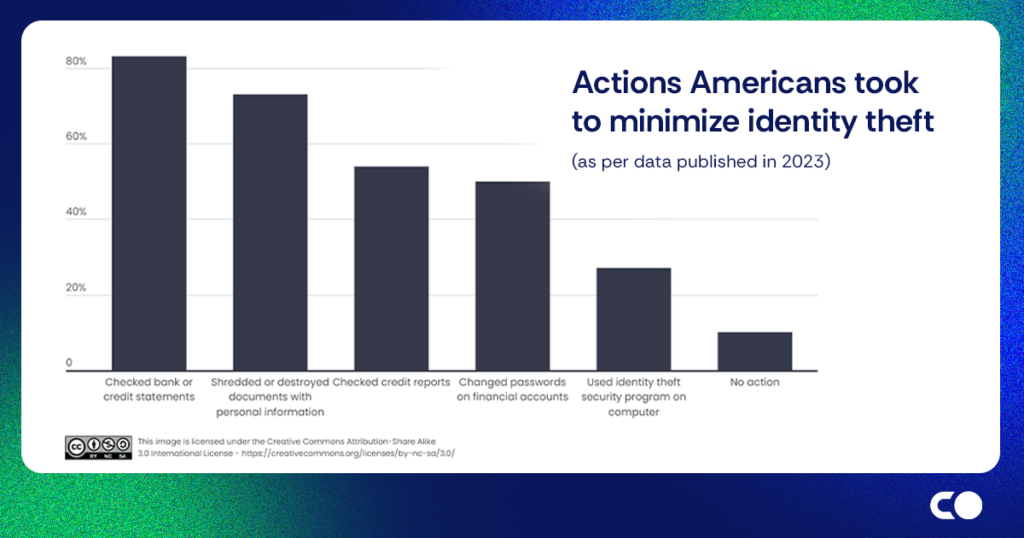
Source: E. Harell, A. Thompson “Victims of Identity Theft, 2021”, Bureau of Justice Statistics, 2023
Identity theft by state
One might think that cybercrime, such as identity theft, would be equally common across all states.
Just consider it—
Since data is mostly stolen via the internet, the victim’s location shouldn’t matter.
But—
It turns out there’s significant variation in identity theft rates among states.
The Federal Trade Commission has developed an index to measure identity theft relative to population size.
Here are the 5 US states with the highest rates of identity theft incidents:

Source: Federal Trade Commission, “Consumer Sentinel Network Data Book 2023,” 2024
The states with the lowest score?
- South Dakota: 94
- Vermont: 97
- Wyoming: 106
- West Virginia: 110
- Alaska: 114
And a bonus:
- Puerto Rico: 51
- The District of Columbia: 478
Stacking it all up
There you have it—
A comprehensive roundup of identity theft statistics, trends, and facts.
The Identity Theft Resource Center predicts a rather grim future, filled with AI-driven identity scams and increasingly sophisticated identity theft crimes.
That may well be the case.
However, some cybersecurity experts see AI-based authentication, biometric methods, and chip cards as effective measures against identity theft.
What are your thoughts?
FAQ
What percentage of people have their identity stolen?
The Bureau of Justice Statistics reports that 1 in 5 Americans (22%) have fallen victim to identity theft in their lifetime. Other estimates suggest that around 26 million Americans (9%) suffer from identity fraud each year.
What is the most common crime of identity theft?
Credit card fraud was the most common type of identity theft in 2023, making up 31% of all cases reported to the Federal Trade Commission. Unauthorized use of bank accounts came in second, with 24% of cases.
How are most identities stolen?
According to the Bureau of Justice Statistics, the majority of identity theft cases (37%) were carried out through cyber-enabled methods, such as online transactions, scam emails, and phone calls. In-person transactions were the second-most common method, accounting for 18% of cases.
What age is at the greatest risk of identity theft?
The FTC report indicates that Americans aged 30–39 face the highest risk of identity theft, constituting 30% of cases in 2023. Correspondingly, The Annual Cybersecurity Attitudes and Behaviors Report reveals that Millennials account for 37% of incidents.
Sources
- AuthenticID. “2024 State of Identity Fraud Report.” Accessed May 22, 2024. https://www.authenticid.com/wp-content/uploads/2024-State-of-Identity-Fraud-Report.pdf.
- DeLiema, Marguerite, David Burnes, and Lynn Langton. “The Financial and Psychological Impact of Identity Theft Among Older Adults.” Last modified October 5, 2021.
https://academic.oup.com/innovateage/article/5/4/igab043/6381666. - Federal Trade Commission. “Consumer Sentinel Network Data Book 2023.” Accessed May 22, 2024.
https://www.ftc.gov/system/files/ftc_gov/pdf/CSN-Annual-Data-Book-2023.pdf. - Guedes, Inês, Martins Margarida, and Carla Sofia Cardoso. “Exploring the Determinants of Victimization and Fear of Online Identity Theft: An Empirical Study.” Last modified July 21, 2022.
https://link.springer.com/article/10.1057/s41284-022-00350-5. - Harell, Erika and Alexandra Thompson. “Victims of Identity Theft, 2021.” Accessed May 22, 2024.
https://bjs.ojp.gov/library/publications/victims-identity-theft-2021. - Identity Theft Resource Center. “2023 Data Breach Report.” Accessed May 22, 2024.
https://www.idtheftcenter.org/publication/2023-data-breach-report/. - Identity Theft Resource Center. “2024 Predictions.” Accessed May 23, 2024.
https://www.idtheftcenter.org/identity-theft-resource-center-2024-predictions/. - Karppinen, Inka, Jason R.C. Nurse, and Joanne Varughese. “The Annual Cybersecurity Attitudes and Behaviors Report 2023.” Accessed May 23, 2024.
https://cybsafe-resources.s3.eu-west-1.amazonaws.com/CYBSAFE-Oh%2C+Behave!+2023-FINAL+REPORT-231002MS.pdf. - Mcclain, Coleen, Michelle Faviero, Monica Anderson, and Eugenie Park. “How Americans View Data Privacy.” Last modified October 18, 2023.
https://www.pewresearch.org/internet/2023/10/18/how-americans-view-data-privacy/. - Onfido. “Identity Fraud Report 2024.” Accessed May 24, 2024.
https://onfido.com/landing/identity-fraud-report/. - Piquero, Nicole Leeper, Alex R. Piquero, Stephen Gies, Brandn Green, Amanda Bobnis, and Eva Velasquez. “Preventing Identity Theft: Perspectives on Technological Solutions from Industry Insiders.” Accessed May 23, 2024.
https://www.taylorfrancis.com/chapters/edit/10.4324/9781003258100-9/preventing-identity-theft-perspectives-technological-solutions-industry-insiders-nicole-leeper-piquero-alex-piquero-stephen-gies-brandn-green-amanda-bobnis-eva-velasquez. - TransUnion. “TransUnion 2024 State of Omnichannel Fraud Report.” Accessed May 24, 2024.
https://www.transunion.com/content/dam/transunion/us/business/collateral/report/GFS-23-F158127-TruVa-2024StateofOmnichannelFraudReport-RPR-US_EN-US.pdf.